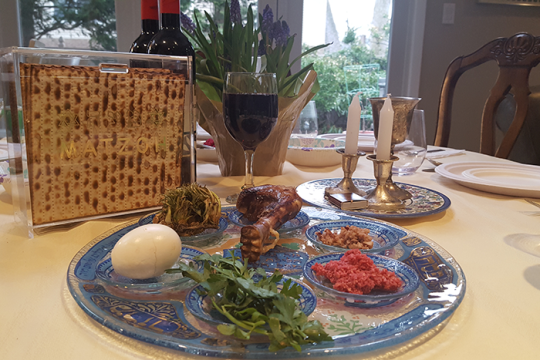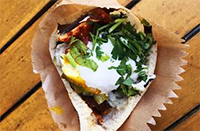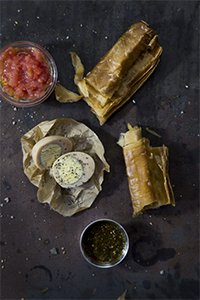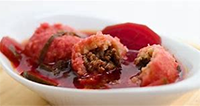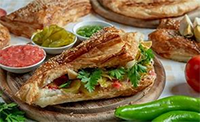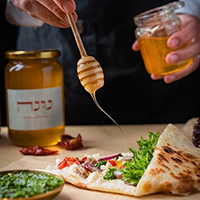
Growing up, my family was endearingly called the "Foodie Rudees," as we lived to eat, and our last name is Rudee. However, I was the odd one out - as an athlete more than a foodie, I ate only to fuel my body. It wasn't until I spent time in Israel in my early 20s and needed to cook for myself that I became inspired by how food can be not only fuel, but a conduit for culture, storytelling, and identity.
As I shopped for groceries in the Machane Yehuda Market in Jerusalem ("The Shuk," as locals call it), I witnessed how the multicultural, vibrant food tells the story of Israel better than any news station could. I took in all the colors, smells, sights, sounds, and flavors, and fell in love with the market. Now, as a Rudee who has embraced her foodie-ness and culinary tour guide in Israel, I often tell visitors that much like the Jewish people itself, Jewish and Israeli foods are a beautiful mosaic, in which cultures and identities come together to create a whole that is so much greater - and so much more meaningful - than the sum of its parts.
In Israel, one can witness the ingathering of exiles prophesized and promised in Deuteronomy 30:3-4 "[God] will bring you together again from all the peoples where your God has scattered you. Even if your outcasts are at the ends of the world, from there your God will gather you, from there [God] will fetch you." Whether by simply going to the market or even at a Shabbat table, you can witness dishes from dozens of backgrounds come together.
The following foods are part of the mosaic created through this ingathering, and can therefore be considered "Israeli," even though they may have origins that predate the modern State of Israel. They are much less known than falafel and hummus (both of which have their origins in Egypt), but should not be overlooked when visiting Israel or frequenting an Israeli restaurant!
1. Sabich
I begin with sabich very intentionally. Unless you're a culinary superstar or Israel expert, chances are you've never heard of this dish. An original Israeli street food, sabich was invented in Ramat Gan in the 1960s by an Iraqi Jew who used to mix all the leftovers from Shabbat - fried eggplant, tomato and other chopped veggies, hardboiled egg, tahina (ground sesame), schug (a Yemenite hot sauce), and amba (a fermented mango and fenugreek dip) into a pita. Sabich is vegetarian and can be made vegan. And it. Is. DELICIOUS!
2. Malawach and Jachnun
Malawach is a crispy, flaky Yemenite pastry and cousin to jachnun - which is essentially a rolled-up malawach. Each is made primarily from flour and margarine or butter and left to bake overnight during Shabbat to be eaten for Shabbat lunch. While it is a Yemenite custom to let jachnun and malawach cook over Shabbat, people from other Jewish cultures may not be comfortable letting something bake over Shabbat. Malawach and jachnun are traditionally served with hardboiled egg, grated tomato, and schug (a spicy Yemenite dip with herbs, jalapenos, garlic, and spices), but each family has its own traditions for other additions. My Yemenite friend also adds beans and shamenet (sour cream) to the dish, and it's become one of my favorite Shabbat dishes. But you don't need to wait until Shabbat to eat it!
3. Kubbeh soup
Marak (soup) Kubbeh is an Iraqi-Kurdish hot soup that can be made with beets, called Kubbeh Adom (Red Kubbeh), or lemon and chard, called Kubbeh Hamusta (Sour Kubbeh). The Kubbeh dumplings in the soup are made from bulgar (a cracked wheat) and are usually stuffed with meat, but you can find vegetarian versions. The Iraqi-Kurds brought this dish to Israel, and it is now a cornerstone of every Iraqi-Kurdish restaurant in Israel. It's like the Mizrahi version of chicken soup - I eat it every time I feel a cold coming on, and eating it feels like a hug from the inside.
4. Bourekas
Bourekas are a Sephardic enriched pastry, like puff pastry, and often filled with cheese, potatoes, or a mix of other savory ingredients like mushrooms, spinach, onions, etc. They're especially delicious when cut open and stuffed like a sandwich with hardboiled egg, tomato, and pickles, which is how they're prepared on the streets of Israel. Bourekas were originally brought to Israel by the Sephardi Jews of Turkey and the Balkans who made it with phyllo dough, but Israelis began using puff pastry to speed up the process. According to Israeli newspaper Haaretz, the Sephardim were likely responsible for adding the final "s" to the Turkish word borek to make it plural in Ladino. In modern Hebrew, the word bourekas can be singular or plural, but many Hebraicize the word by adding the plural suffix "im," bourekasim. Pro tip: In Israel, because of the kosher dietary laws, consumers need to know which bourekas have dairy inside and which do not, so the dairy ones are triangular and the non-dairy are square or rectangular. Whichever version you choose, make sure to ask the vendor to heat your bourekas and eat them warm on the spot!
5. Mufletas
Mufletas are a traditional Moroccan crepe eaten after Passover during Mimouna. They're also eaten year-round for breakfast with butter and honey. In the Jerusalem Shuk this year, Chef Itzik Levy started filling his mufletas with savory ingredients like mozzarella, feta, and roasted and fresh veggies. He named his basta (market stall) for his grandmother, and even serves his dishes on her original plates from Morocco. I love his creative mufletas, and am all for eating them all year, no matter the time of day!
Related Posts

The Sticky Stuff That Holds Us Together: Cheese

Judaism: The Faith of Feasting
